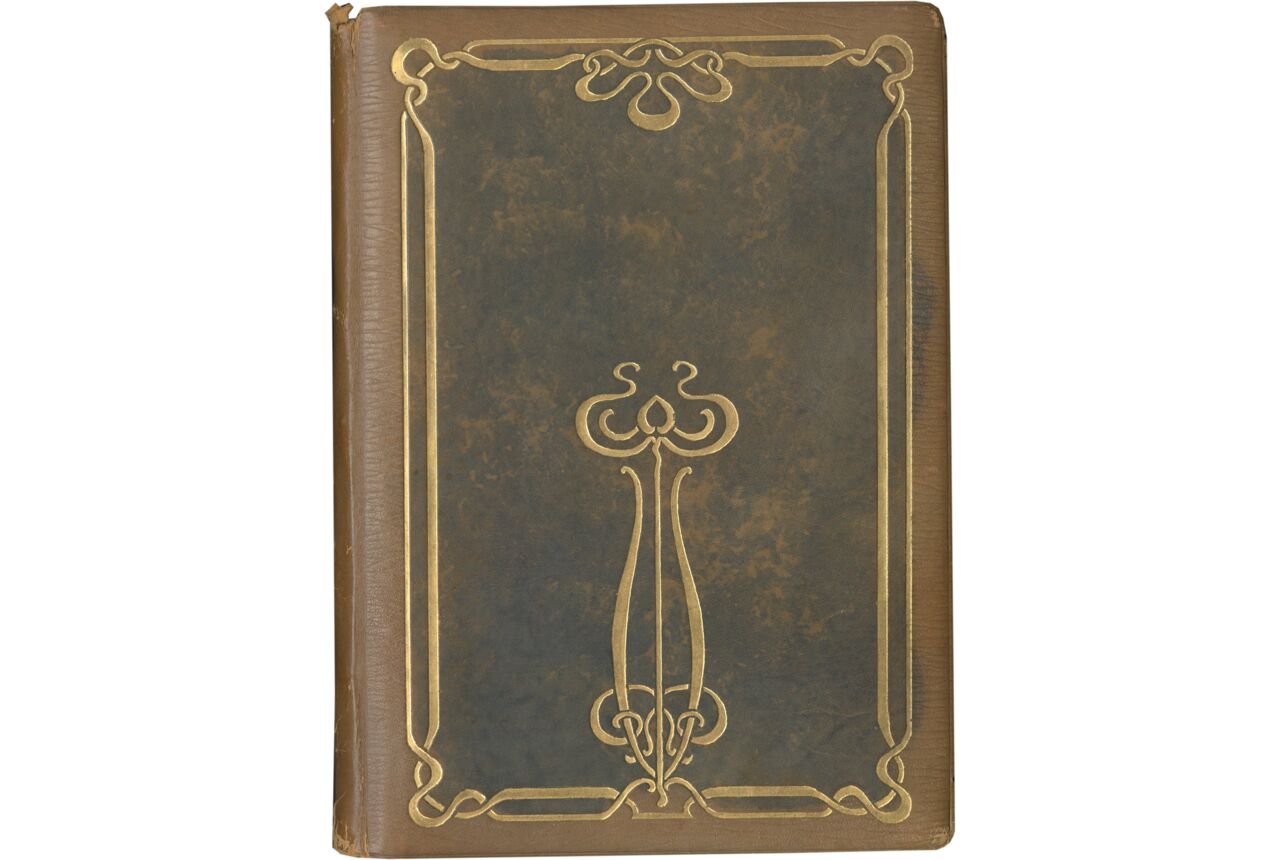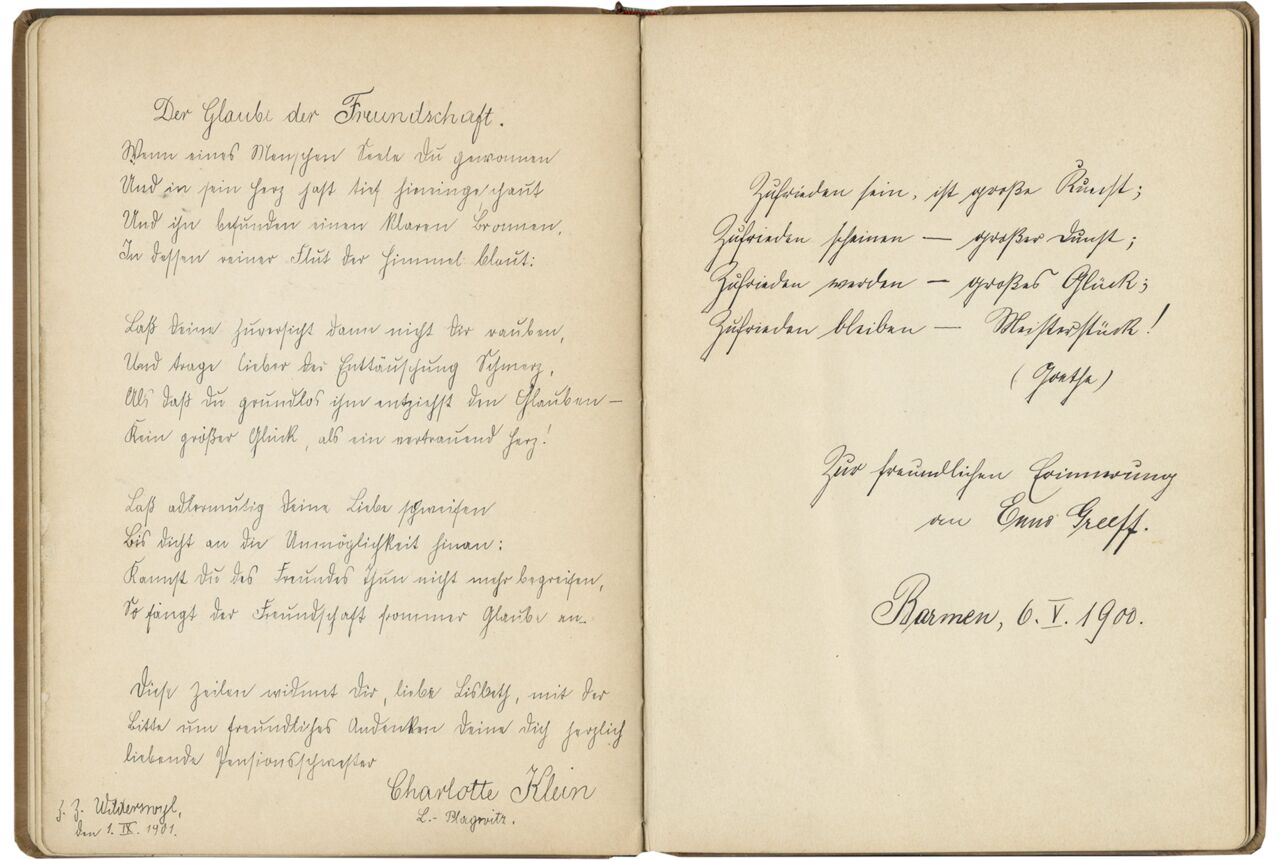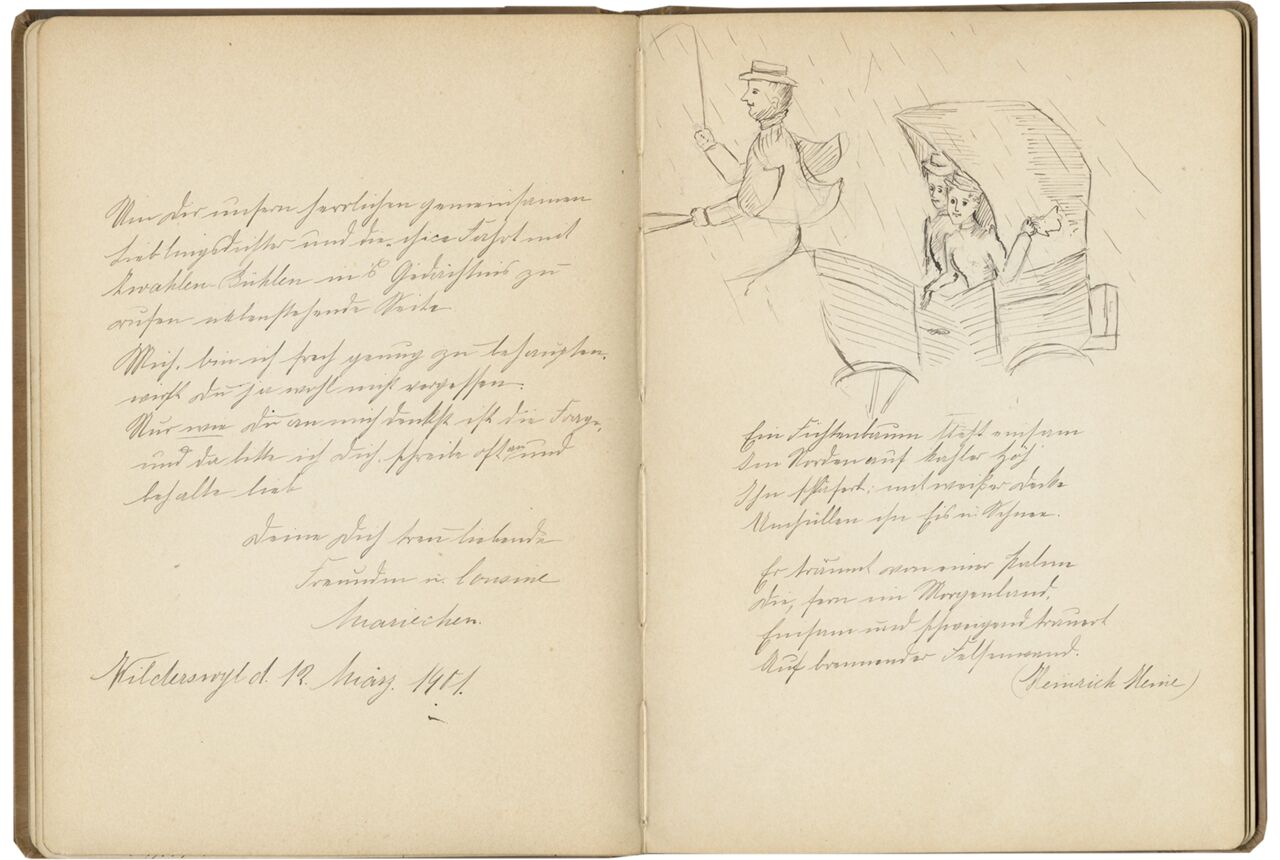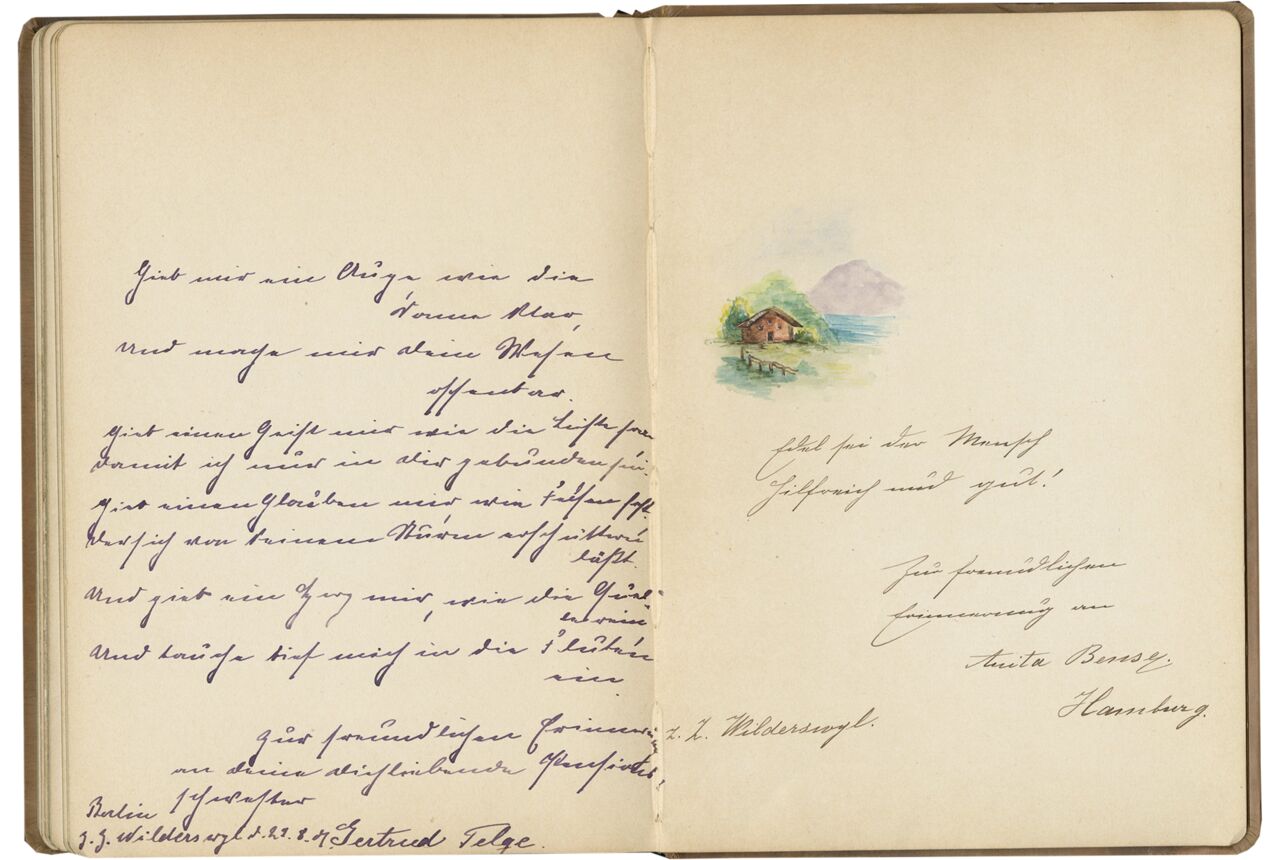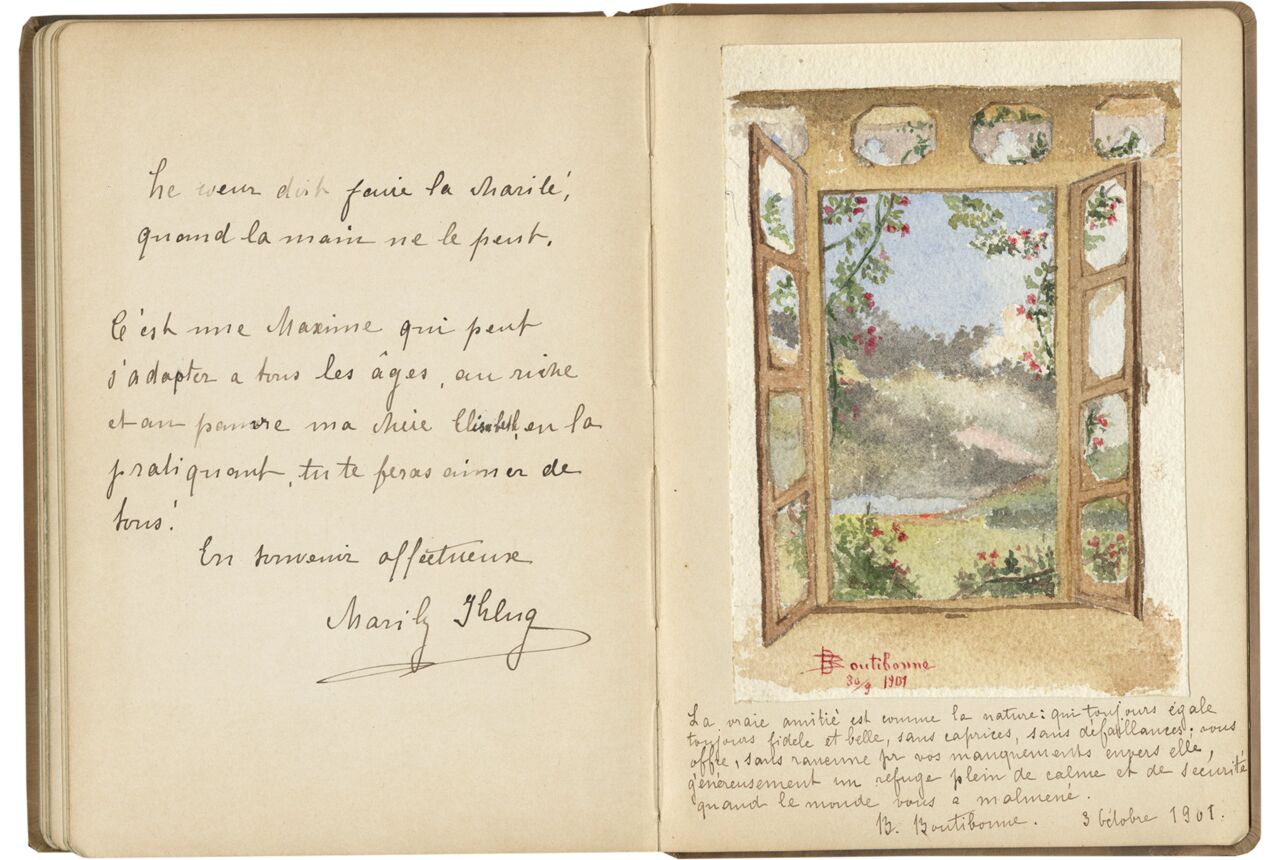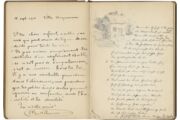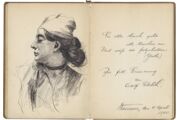i + 39 + i folios on paper, modern foliation in pencil, 1-39, THREE WATERCOLORS, THREE PEN AND INK DRAWINGS, INCLUDING ONE BY ADOLF ERBSLÖH, paper slightly browned (due to paper of the period), in overall pristine condition. In its splendid original binding of brown morocco, front cover gold-tooled with a magnificent Art Nouveau design, flat spine, edges painted, leather slightly broken at the top of the spine and worn in the corners, otherwise in excellent condition. Dimensions 136 x 195 mm.
Most of the entries in Elisabeth’s friendship album were made at Villa Unspunnen, a hotel in Wilderswil in the Swiss Alps. The exciting circle of international artists and intellectuals gathered there is brought to life in this precious manuscript. Included are a very fine pen and ink drawing by the young Adolf Erbslöh (1881-1947), the famous German Expressionist painter (f. 23v), as well as an entry by Dr Hugo Graetzer (1879-1942), personal physician to the Prince of Bulgaria, who was killed in 1942 during the Holocaust (f. 25), watercolors by Margreth Erbslöh, sister of Adolf Erbslöh (f. 15) and by B. Boutibonne, a relative of the French painter Charles-Edouard Boutibonne (1816-1897) (f. 39), and an entry by Elisabeth Schiemann (1881-1972), a German geneticist and crop plant researcher (f. 35v).
Provenance
1. The album was made for a woman named Elisabeth (see e.g. ff. 30v, 38v; familiarly “Lisbeth,” ff. 18v, 29v, 30, 31v). The poem on f. 10v suggests that her last name was Amann (see below). In 1900 she was staying in Barmen and visited Antwerp and a few cities in Germany; entries from Wilderswil were added on the versos when she was staying at the Villa Unspunnen in Wilderswil in Switzerland in 1900-1901 (see below).
Illustration
f. 14, Very fine pen and ink drawing of an old water mill, accompanied by a poem in German, signed at the end, “Freundin Märchen (fairytales among friends) Pehard (?)”;
f. 15, Very fine watercolor of roses, accompanied by a poem on ff. 14v-15, signed at the end by Margreth Erbslöh (1884-1962), sister of Adolf Erbslöh;
f. 20, Pen and ink drawing representing two ladies in a carriage by Mariechen, accompanied by a poem of Heinrich Heine copied on ff. 19v-20;
f. 23v, Exceptionally fine pen and ink drawing representing a young woman seen in profile by Adolf Erbslöh, with a line from Goethe and a dated dedication on f. 24, “Barmen, den 4. april 1900”;
f. 37, Small watercolor representing a local landscape in Wilderswil with a small chalet and the Lake Thun seen in between the mountains, painted by Anita Bensy;
f. 39, Very fine watercolor by B. Boutibonne representing a view through an open window, painted on artist’s paper that was pasted onto the page, accompanied by an inscription “La vraie amitié est comme la nature: qui toujours égale toujours fidèle et belle, sans caprices, sans défaillances; vous offre, sans rancune pour vos manquements envers elle, généreusement un refuge plein de calme et de sécurité quand le monde vous a malmené. B. Boutibonne. 3 octobre 1901.” (followed on the verso by an inscription made by Jeanne Boutibonne);
Jeanne and B. Boutibonne are recorded among the active members of the women’s organization in Interlaken (two kilometers from Wilderswil) during the winter season 1906/7 (“Bericht...,” p. 8; see Online Resources); their brother(?), the famous painter Charles-Edouard Boutibonne died in Wilderswil in 1897.
Text
Other entries, mainly poems, are by Antonia Pater(?) (f. 2), Anna Müller (f. 3), Ida Merklinghaus (f. 4), Ewald Merklinghaus (f. 5), Waldemar Zetzsche (f. 6), Maria Zetzsche (f. 7), Paul Thyssen (f. 8), Pierre Mourroz (?) (f. 8v), Mathilde Merklinghaus (f. 9), Olga Klug (f. 9v), Margareta (f. 10), J. H. Birch (f. 10v), Ernst Vetter (f. 11), Ella Kromsehröder (ff. 11v, 12v), Clara (f. 12), Marie Vetter (f. 13), “La vieille amie” Boutibonne (f. 13v), Meta Lepper (f. 15v), Albert Knapp (f. 16), Wally Olsen (f. 16v), Carl (f. 17), Maia Künsemüller (f. 17v), Walter (f. 18), Bessie Voelkerling (f. 18v), Emmi Walter (f. 19), Margarethe Prümer (f. 20v), Heida vonDäum (f. 21), Bertha Grütter (f. 21v), Emmy Ordelheide (f. 22), Charlotte Klein (f. 22v), Enno Greeff (f. 23), Lauthe Howard (f. 24v), Marthe Graetzer and Hugo Graetzer (f. 25), Trude Schmiet (f. 25v), Elly Frick (f. 26), Germaeen Peale (f. 26v), Otto Sander (f. 27), von Reutter (f. 27v), Ida Sander (f. 28), Elizabeth Peope Wistar (f. 28v), Willy Sander (f. 29), Gisela Oberhäuse (?) (f. 29v), Erna Sander (f. 30), Mary Clift Fitch (?) (f. 30v), Marie Bouchsein (f. 31), Grotrüd (?) (f. 31v), Anna Sapper (f. 32), Hannchen Schulze (f. 32v), Milly (f. 33), Lucia Beldy (f. 33v), Anna Huston Miller (f. 34), Reiga (?) (f. 34v), Helene Heyder (f. 35), Elisabeth Schiemann (f. 35v), Magnus Schiemann (f. 36), Gertrud Telge (f. 36v), Elsa (?) (f. 37v), Erna (f. 38), Marily Thlug (f. 38v), and Jeanne Boutibonne (f. 39v).
Adolf Erbslöh was born in New York in 1881, but after 1888 was raised in Barmen in Western Germany. The pen and ink drawing of a woman on f. 23v is dated in Barmen on 4th April 1900. Soon after, he spent a three-year period of traveling and studying abroad, before enrolling at the Academy of Fine Arts in Karlsruhe. Erbslöh moved to Munich in 1904, where he continued his art education and established his own studio. In 1909, Erbslöh formed the Neue Künstlervereinigung München with the emerging Expressionist artists, Alexei von Jawlensky, Marianne von Werefkin, Vasily Kandinsky and others. The group formed the basis of the “Blauer Reiter” group. The drawing in our manuscript adds an exciting previously unknown work to his œuvre.
The international spectrum of Elisabeth’s entourage at the Villa Unspunnen is illustrated by the entries written in German, French, and English. Her circle included new friends from as far as the United States; see, for instance, the entry on f. 30v: “In remembrance of the pleasant days at Wilderswyl where I knew my dear Elisabeth. Mary Clift Fitch Skaneatles New York, U.S.A. June twenty-second nineteen hundred and one Villa Unspunnen,” or the entry on f. 34 by Anna Huston Miller of Philadelphia.
The entries suggest that on April 12, 15, and 16 in 1900 Elisabeth was in Antwerp, and that she was in Barmen on April 29, May 6, 7, 10, 12, and 24, and in September that year. In May 1900 she travelled to Gerresheim (May 7), Langenberg (May 8), Oberkassel (May 8), Langersfeld (May 9) and Rauenthal (May 10). She appears to have been staying continually in Wilderswil from at least June 15 in 1900 until December 16 in 1901. On the ff. 1-26 almost all mentions of Wilderswil are on the verso (originally blank folio) facing earlier inscriptions. Beginning on f. 32, all mentions are of Wilderswil, both for 1900 and 1901.
Further research might reveal the identity of Elisabeth, the owner of our manuscript. A possible hint lies in the entry on f. 10v in the two poems by J. H. Birch, entitled A Wish followed by a quatrain, in which he apologizes to a woman whose last name is Amann: A Wish, “If but the feelings of respect,/ That hold ‘twixt you and me,/ Could some day bear their semblance/ In a wider still degree,/ Then Bah to all the ‘rotters’,/ all the French and Russian plotters,/ That dare to utter “Fie on the eagle and the lion!”/; [quatrain], “A repentant culprit wishes to express/ his sorrow that one evening at a dance/ he treated as a man her who was/ in reality Amann, yet not a man./”
The album amicorum, or album of friends, is a booklet in which the owner collected entries made by their friends and relatives, usually offering poems, wishes, drawings and watercolors, signed with a date and location. The album amicorum was popular from the sixteenth until the nineteenth century. It was initially favored by men in aristocratic, bourgeois and university circles, and entries were collected from acquaintances met during travels and studies. However, at the beginning of the nineteenth century, the albums were increasingly made for women. In this album, made for a woman, most of the entries are also by women. The album amicorum is central in modern transdisciplinary research studying texts, reception and collecting in cultural and social contexts and the history of mentalities; see especially the comprehensive study by Werner Wilhelm Schnabel published in 2003. Albums for women have generally been less studied than have those for men (see Reinders, 2016 and 2017, studying early examples of albums for women).
Literature
Fechner, J.-U., ed. Stammbücher als kulturhistorische Quellen, Wolfenbütteler Forschungen 11,
Munich, 1981.
Keil, R. and R. Die deutschen Stammbücher des sechzehnten bis neunzehnten Jahrhunderts. Ernst und Scherz, Weisheit und Schwank in Original-Mittheilungen zur deutschen Kultur-Geschichte, Berlin, 1893 (reprint Hildesheim, 1975).
Klose, W. “Stammbücher: eine kulturhistorische Betrachtung,” Bibliothek und Wissenschaft 16 (1982), pp. 41-67.
Kurras, L. Zu gutem Gedenken. Kulturhistorische Miniaturen aus Stammbüchern des Germanischen Nationalmuseums 1570-1770, Munich, 1987.
Lilienthal, M. Schediasma critico-literarium de philiothecis varioque earundum usu et abusu, vulgo von Stamm-Büchern, Königsberg, 1712; rev. Wittenberg, 1740 (repr. in Fechner, 1981, pp. 237-298). [the first study of Alba Amicorum].
Nickson, M.A.E. Early Autograph Albums in the British Museum, London, 1970.
Reinders, Sophie. De mug en de kaars. Vriendenboekies van adellijke vrouwen, 1575-1640, Nijmgen, 2017.
(Summary of her dissertation (English) https://www.academia.edu/35402416/Summary_docx)
Reinders, Sophie. “Social Networking is in Our DNA: Women’s Alba Amicorum as Places to Build and Affirm Group Identities,” in Dieuwke Van Der Poel, Louis P. Grijp, and Wim van Anrooij, eds., Identity, Intertextuality, and Performance in Early Modern Song Culture, Leiden, 2016, p. 150-177.
https://brill.com/display/book/9789004314986/B9789004314986_007.xml
Rosenheim, M. The album amicorum, Oxford, 1910.
Schnabel, W. W. Das Stammbuch: Konstitution und Geschichte einer textsortenbezogenen Sammelform bis ins erste Drittel des 18. Jahrhunderts, Berlin, 2003.
Schünemann, H. “Stammbücher,” Schrifttumsberichte zur Genealogie und zu ihren Nachbargebieten 2 (1965), pp. 67-108.
Taegert, W. Edler Schatzholden Erinnerns: Bilder in Stammbüchern der Staatsbibliothek Bamberg aus vier Jahrhunderten, Bamberg, 1995.
Thomassen, K., ed. Alba amicorum. Vijf eeuwen vriendscap op papier gezet. Het album amicorum en het poëziealbum in de Nederlanden, Maarssen/The Hague, 1990.
Online Resources
Adolf Erbslöh (Wikipedia)
https://en.wikipedia.org/wiki/Adolf_Erbsl%C3%B6h
Elisabeth Schiemann (Wikipedia)
https://en.wikipedia.org/wiki/Elisabeth_Schiemann
Charles-Edouard Boutibonne (Wikipedia)
https://fr.wikipedia.org/wiki/Charles-%C3%89douard_Boutibonne
“Bericht des Frauen-Arbeitsverein von Interlaken”
chrome-extension://efaidnbmnnnibpcajpcglclefindmkaj/https://www.frauenverein-interlaken.ch/application/files/6315/8074/3035/Bericht_1906-1907.pdf
Repertorium Alborum Amicorum
https://raa.gf-franken.de/de/startseite.html
(our manuscript is not recorded)
TM 1278


